

Noumea subnivalis
Baba, 1987
Order: NUDIBRANCHIA
Suborder: DORIDINA
Superfamily: EUDORIDOIDEA
Family: Chromodorididae
DISTRIBUTION
Known only from Japan
PHOTO
Echizen Beach, Echizencho Coast, Japan. Depth: 7m. Size: 15mm., 11 Aug, 2001. Upper Photo: Nishina Chikako. Lower Photo: Kahoru Imamoto.
In the Baba's description of N. subnivalis he notes:
"the back is pure white (snow white) without any sign of yellow or orange-yellow spots on it. The mantle margin has a double border of orange-yellow at the edge and yellow inside. ... The rhinophores are reddish purple above and colourless below. The branchial plumes are almost entirely pure white ...."
The most important external features distinguishing this species are the scattered pointed papillae on the mantle and the colour band around the mantle margin. Rather than being two distinct bands, there is a single irregular band which gradually changes in colour from red, on the outside, to orange-yellow on the inside. The body and mantle are opaque white, the gills are white and the rhinophore clubs are deep red with white edging. [see my comments on Yasuhiro Shirai's message, and Nishina Masayoshi's message].
Compare this to the similarly coloured:
• Noumea nivalis - has a single orange-yellow band around the mantle edge; the upper half of the rhinophore club is orange, the lower white, and the white gills are orange tipped. There can sometimes be a few diffuse orange spots on the mantle.
• Chromodoris verrieri - two distinct colour bands at mantle edge: outer band red, inner band yellow. The rhinophore club is red with white edging to the lamellae.
References:
• Baba, K (1987) A new species of Noumea from Ogi, Toyama Bay and vicinity, Japan (Nudibranchia: Chromodorididae). Venus, The Japanese Journal of Malacology, 46(1): 19-24.
• Baba, K (1987): Noumea sp. from Echizencho Coast, Japan. Janolus, 69: 2.
Rudman, W.B., 2001 (August 13) Noumea subnivalis Baba, 1987. [In] Sea Slug Forum. Australian Museum, Sydney. Available from http://www.seaslugforum.net/find/noumsubn
Related messages
Southernmost record of Noumea subnivalis
September 26, 2002
From: Nishina Masayoshi
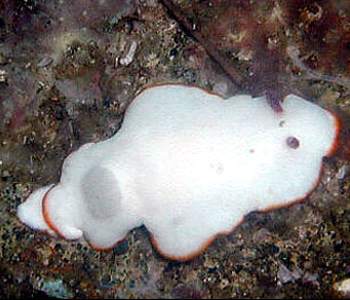
Dear Bill,
I have recently found a photo of Noumea subnivalis. The photographer didn't recognize the species but I am pretty sure that this is N. subnivalis, which would make this the southernmost record of the species, as far as I know. I am very grateful for his permission to use it to your Forum.
Photo by Mr. Kaoru Imagawa
Loc: Tanoura beach, Oita city, Oita prifec. Kyusyu. Japan.
Date: 4 Aug, 2001
Leng: 15mm
Depth 2m
Wather temp: 28C degree.
Best Regards,
Nishina Masayoshi
nishina@wips.co.jp
Masayoshi, N., 2002 (Sep 26) Southernmost record of Noumea subnivalis. [Message in] Sea Slug Forum. Australian Museum, Sydney. Available from http://www.seaslugforum.net/find/7990Thanks Nishina,
Yes this is Noumea subnivalis. It will be interesting to see just what the geographic range of this species is.
Best wishes,
Bill Rudman
Re: Noumea subnivalis?
August 21, 2001
From: Yasuhiro Shirai
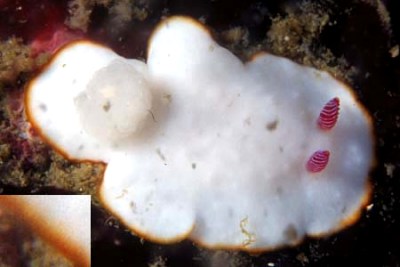
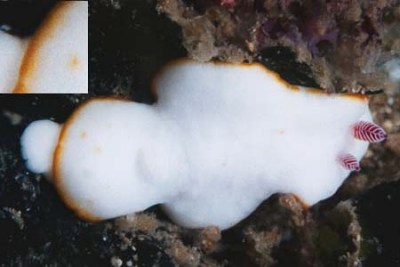
Dear Bill,
Today,I send two image files for reference.
UPPER: This is another photo of the animal I sent a photo of in my earlier message. [Nansei area, Kii Peninsula, Japan, July, 2000 - Depth: 10m
Size: 30mm].
LOWER: This is another individual which I think is the same4 species, but it has yellow spots on his back. It is from
the Nantoh area, Kii Peninsula, central Japan. Depth 18m; Length 25mm; August 1999.
Sincerely.
Yasuhiro Shirai
yasuhiro@sea-slug.com
Shirai, Y., 2001 (Aug 21) Re: Noumea subnivalis?. [Message in] Sea Slug Forum. Australian Museum, Sydney. Available from http://www.seaslugforum.net/find/5107Dear Yasuhiro,
Thanks for these photos. It certainly seems that both your animals have the typical mantle edge of Noumea subnivalis where the colour gradually changes from red-orange on the outside to yellow on the inside. At least in the upper photo there are distinct signs of the mantle papillae which are so clear in Kahoru Imamoto's photo in Nishina Masayoshi's recent message.
If they are indeed the same, and I think they are, it seems Noumea subnivalis can sometimes have yellowish diffuse spots on the mantle, like Noumea nivalis.
Best wishes,
Bill Rudman
Another photo of Noumea subnivalis
August 21, 2001
From: Nishina Masayoshi
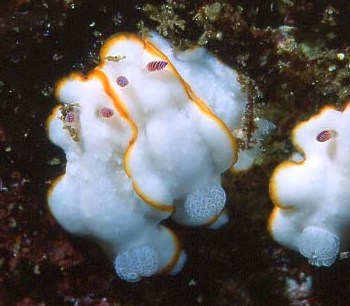
Dear Dr.Rudman,
I found this photo on a Japanese website and the photographer Mr T. Kenji is pleased to give his permission for his photograph to be carried by the Forum if these are of N. subnivalis and useful.
Date:1 July,2001
Location: Omijima, Yamaguchi Prefecture
Yamaguchi Prefecture is located in the southernmost tip in Honshu (Main island of Japan). Depth:6M
Found by M. Fumiko
Photo by T. Kenji
Best Regards,
Nishina Masayoshi
nishina@hpe15.wips.co.jp
Nishina, M., 2001 (Aug 21) Another photo of Noumea subnivalis. [Message in] Sea Slug Forum. Australian Museum, Sydney. Available from http://www.seaslugforum.net/find/5116Dear Nishina,
Thanks very much for this photo. I'm glad now that the first photo of N. subnivalis that Yasuhiro Shirai sent us was so difficult to identify. The discussion that has followed has meant we now have a number of good photos of this species and a much clearer understanding of the differences between it and Chromodoris verrieri and Noumea nivalis.
In this photo it is interesting to see how the mantle forms a fold on each side when the animals are not moving and 'nestled'. Quite a few species of Noumea assume this position when at rest. Another interesting point is why they cluster together like this? The three on the left are all facing the same way, so this clustering is not a mating position. Perhaps they are attracted together by pheromones, or by following mucus trails, or perhaps they are clustered on a small colony of their preferred food sponge.
Best wishes,
Bill Rudman
About Noumea subnivalis
August 18, 2001
From: Nishina Masayoshi


Dear Dr.Rudman,
I am a amateur but I have tried to consider the issue you raised about the identity of Noumea subnivalis.
Here is my translation of the Japanese part of Baba's original description.
"Mantle edge is surrounded with bi-colour of outer orange and inner yellow. Coloration of upper half of the rhinophore is reddish purple. Gills are white ... The mantle back has a small tubercles. The back is pure white (snow white) without any sign of orange-red spots on it. Tip of tail foot is not dyed yellow."
First. His description of the mantle edge doesn't actually mention two separate 'bands' so I feel that he is not necessarily talking about a clear boundary between orange and yellow. It can be conjectured to be an ambiguous boundary line. Secondly, He wrote just "rhinophore is...", no more detail description. No mention about which part of the rhinophore. And lastly, I particularly noticed that he mentioned "small tubercles on the back". I thought this was significant because my animal has it. It is very difficult to see it but I feel they are small tubercles.
Please refer to the attached images which are of the same animal. Date: 11 Aug, 2001
Location, Echizen Beach. Depth: 7m. Size: 15mm. (this is the same place that Baba refers to in 1987. [Baba, K (1987): Noumea sp. from Echizencho Coast, Japan. Janolus, 69: 2.) Echizen Beach is on the Echizencho Coast of Japan. Upper Photo by Nishina Chikako, Lower Photo by Kahoru Imamoto.
So, if you think if my animal is Chromodoris verrieri too, I also think that N. subnivalis is a synonym of C. verrieri.
Best Regards,
Nishina Masayoshi
nishina@hpe15.wips.co.jp
Nishina, M., 2001 (Aug 18) About Noumea subnivalis. [Message in] Sea Slug Forum. Australian Museum, Sydney. Available from http://www.seaslugforum.net/find/5100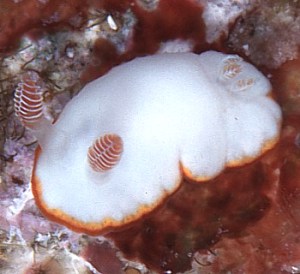
PHOTO: C. verrieri, 6 mm long, Kerama Is. Photo: Atsushi Ono.
Dear Nishina,
Thanks very much for your thoughts and the extra photos, they are very useful. These photos and your translation of the Japanese section of Baba's description certainly clarify the external differences between N. subnivalis and C. verrieri. Although there were clear anatomical differences, Baba's description of the external colour was not totally clear. However your photos showing the nature of the mantle border and the papillae on the mantle certainly fit Baba's description. I have included alongside Atsushi Ono's photo of an animal from Kerama Is which I identified earlier as C. verrieri for comparison. It is a 6mm long juvenile and yet we can clearly see the distinct red and orange-yellow bands around the mantle edge. Quite different from your 15mm animal where the colour gradually changes from red through orange to yellow.
I think we can use the nature of the coloured mantle border and the mantle papillae as the important external distinguishing features of this species. I'm afraid it doesn't help to identify of the animal in Yasuhiro Shirai's recent photo. To me the colour border is in two distnct bands so I think it is probably best to consider it to be C. verrieri.
And please don't apologise for being an amateur. The word 'amateur' comes from the Latin word for 'love' and basically means someone 'who does what they do out of love for it' - and we can't ask much more than that. 'Amateurs' have always been an invaluable source of information for me. Professionals can't afford to ignore the observations of interested amateurs who vastly outnumber the few people worldwide who are lucky enough to be employed to study sea slugs. One of my major reasons for starting the Forum was to provide a place where amateurs could record their observations so that they would be available to us all and where their participation could be acknowledged.
Thanks again,
Bill Rudman
Noumea subnivalis? from Japan
August 14, 2001
From: Yasuhiro Shirai
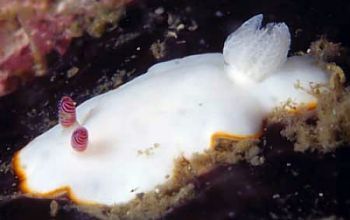
Dear Bill,
Here is a photo of Noumea subnivalis.
I took it in July, 2000 at Nansei area, Kii Peninsula, Japan.
Depth:10m
Size: 30mm
Yasuhiro Shirai
yasuhiro@sea-slug.com
Shirai, Y., 2001 (Aug 14) Noumea subnivalis? from Japan. [Message in] Sea Slug Forum. Australian Museum, Sydney. Available from http://www.seaslugforum.net/find/5080Dear Yasuhiro,
Thanks for the photo, but I think this is probably Chromodoris verrieri rather than Noumea subnivalis.
I am still having difficulty identifying N. subnivalis. In the Baba's description of N. subnivalis he notes:
"the back is pure white (snow white) without any sign of yellow or orange-yellow spots on it. The mantle margin has a double border of orange-yellow at the edge and yellow inside. ... The rhinophores are reddish purple above and colourless below. The branchial plumes are almost entirely pure white ...."
Compare this to the similarly coloured:
• Noumea nivalis - has a single orange-yellow band around the mantle edge; the upper half of the rhinophore club is orange, the lower white, and the white gills are orange tipped. There can sometimes be a few diffuse orange spots on the mantle.
• Chromodoris verrieri - the outer band around the mantle border is red, not orange-yellow, and the rhinophore club is red with white edging to the lamellae.
In N. subnivalis, Baba describes the rhinophore as "reddish purple at the tip and white below", but I am not sure if he is referring to just the club or the rhinophore stalk as well. If it were not for the radular morphology, as described by Baba, I would consider N. subnivalis to be almost certainly a synonym of C. verrieri. One very distinctive point is Baba's description of the background colour being "pure white (snow white)" which suggests that it has an opaque white background colour which is unusual as in most species the colour is a translucent white. Interestingly C. verrieri also has an opaque white background colour.
I guess what we have to try and find is an animal with an 'orange-yellow' outer and yellow inner mantle margin.
References:
• Baba, K (1987) A new species of Noumea from Ogi, Toyama Bay and vicinity, Japan (Nudibranchia: Chromodorididae). Venus, The Japanese Journal of Malacology, 46(1): 19-24.
• Baba, K (1987): Noumea sp. from Echizencho Coast, Japan. Janolus, 69: 2.
Best wishes,
Bill Rudman
